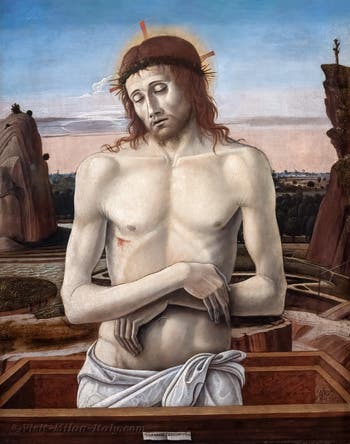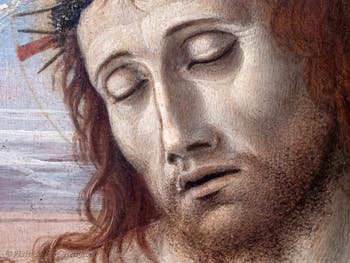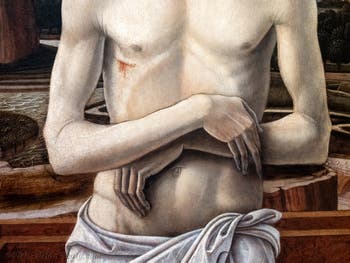Museums Ambrosiana | Castello Sforzesco | Poldi Pezzoli
Poldi Pezzoli Artists | Location | Opening Hours Tickets | Authorizations
Artists Bellini | Botticelli | Canaletto | Carriera | Cranach | Daddi | Francesca | Giordano | Guardi | Lippi F. | Lotto | Luini | Mantegna | Montagna | Memling | Palma | Pinturicchio | Pollaiolo | Raphael | Tiepolo | Titian | Weapons Room
Giovanni Bellini “Pietà, Imago Pietatis Man of Sorrows” Poldi Pezzoli Museum in Milan in Italy
Giovanni Bellini (1427 — 1516) “Pietà, Imago Pietatis Man of Sorrows”
Painting - Tempera on Wood (50 x 40.4 cm) 1457
Pietà Imago Pietatis Man of Sorrows This “Imago Pietatis”, this “Man of Pain” painted by Giovanni Bellini, is a work of his youth when he was still greatly influenced by the style of his brother-in-law Andrea Mantegna.
A resurrection of Christ that Bellini set at dawn, at sunrise and therefore at the day's rebirth.
Giovanni Bellini painted this aurora in a pink colour against the background of Christ, still very pale, which allows the painter to highlight the traces of his death that are still present.
Christ, who emerges from his tomb at this moment, is still between death and life.
His dull body and his weary face, still devoid of the colours of life, present him to us in an even more dramatic way.
The white areas painted by Bellini on the cheeks and above the eyes embedded in their sockets outline the skull bones under the skin of the face.

Pietà Imago Pietatis Man of Sorrows The way Bellini used these white areas to show us this passage from death to life is a proper stroke of the artist's genius.
The body of Christ is in the foreground; it captures and reflects all the light in the picture and almost prevents us from seeing what is around it.
Christ is still dead, yet all the light emanates from him alone.
You can still see the wound under his right breast, a slightly bleeding wound.
This artistic freedom taken by Bellini by letting blood escape again from the wound of Christ could also mean that it has reopened with his return to life to show us the pain caused by his sacrifice to save men.

Pietà Imago Pietatis Man of Sorrows Artistic freedom is all the more evident as there is not the slightest trace of the stigmata of the crucifixion on Christ's hands.
This is not an oversight but a voluntary choice on the part of Giovanni Bellini, as the radiographic analysis of the painting carried out during its restoration in 2010 showed that the stigmata were included in the initial drawing under the painting.
This choice by Bellini would be consistent with that made by Filippo Lippi 25 years earlier when he painted his “Imago Pietatis”, which you can also admire at the Poldo Pezzoli Museum in Milan.

Pietà Imago Pietatis Man of Sorrows It is difficult to say about Filippo Lippi if the hands of his Christ are devoid of stigmata given their position; however, the body shows no wounds or visible traces of the crucifixion.
Did Giovanni Bellini see, and would Lippi's painting have influenced him?
Unfortunately, there is no evidence to confirm this, but it is a possible explanation.
The Bellini Christ is presented in a rocky and arid environment that opens onto green countryside where water flows on the horizon on the right side as a sign of hope for humanity after the redemption of its sins.
On the rocky sides surrounding the tomb, we can see a dry tree on the right cape and green bushes on the left.
These living bushes represent the human race's rebirth and redemption through Christ's sacrifice.
Artists Bellini | Botticelli | Canaletto | Carriera | Cranach | Daddi | Francesca | Giordano | Guardi | Lippi F. | Lotto | Luini | Mantegna | Montagna | Memling | Palma | Pinturicchio | Pollaiolo | Raphael | Tiepolo | Titian | Weapons Room
Poldi Pezzoli Artists | Location | Opening Hours Tickets | Authorizations
Museums Ambrosiana | Castello Sforzesco | Poldi Pezzoli
Back to Top of Page



